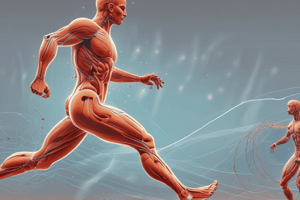Podcast
Questions and Answers
What is the primary focus of exercise physiology?
What is the primary focus of exercise physiology?
- Exploring the benefits of meditation on metabolism
- Understanding the role of exercise on the body (correct)
- Studying the effects of diet on the body
- Investigating the impact of sleep on muscle activity
In exercise physiology, what does ATP stand for?
In exercise physiology, what does ATP stand for?
- Adenosine Trisodium Phosphate
- Adenosine Triphosphate (correct)
- Adaptive Tissue Protein
- Acute Training Program
Why is it important to study exercise physiology?
Why is it important to study exercise physiology?
- To understand how exercise affects the different body systems (correct)
- To analyze the impact of music on physical endurance
- To explore the effects of weather conditions on muscle recovery
- To learn about the history of sports performance
What does exercise physiology aim to investigate from a subcellular level?
What does exercise physiology aim to investigate from a subcellular level?
Who does exercise physiology serve according to the text?
Who does exercise physiology serve according to the text?
What is cardiovascular endurance?
What is cardiovascular endurance?
What term describes the state of dynamic balance of the body's internal environment?
What term describes the state of dynamic balance of the body's internal environment?
Which term refers to the ability of a muscle or muscle group to exert force repeatedly or over a period of time?
Which term refers to the ability of a muscle or muscle group to exert force repeatedly or over a period of time?
Which of the following is NOT a health benefit of physical activity mentioned?
Which of the following is NOT a health benefit of physical activity mentioned?
What is the primary focus of skill-related components of fitness?
What is the primary focus of skill-related components of fitness?
What type of physical activity is planned, structured, repetitive, and purposeful?
What type of physical activity is planned, structured, repetitive, and purposeful?
What activity can be characterized as body movement produced by muscle action that increases energy expenditure?
What activity can be characterized as body movement produced by muscle action that increases energy expenditure?
How is physical fitness defined?
How is physical fitness defined?
What does chronic adaptation refer to?
What does chronic adaptation refer to?
Which of the following is NOT a term or concept required to understand exercise physiology?
Which of the following is NOT a term or concept required to understand exercise physiology?
What is the primary purpose of applying physical fitness tests to target populations?
What is the primary purpose of applying physical fitness tests to target populations?
In terms of fitness, what does body composition primarily refer to?
In terms of fitness, what does body composition primarily refer to?
Which type of exercise involves muscle contractions performed at a constant velocity?
Which type of exercise involves muscle contractions performed at a constant velocity?
What type of muscle fibers are characterized by being large in diameter, light in color, and having high glycogen content?
What type of muscle fibers are characterized by being large in diameter, light in color, and having high glycogen content?
Which ability is defined as the ability of the body to maintain an upright posture while still or moving?
Which ability is defined as the ability of the body to maintain an upright posture while still or moving?
Which type of exercise is characterized by muscle exerting force against an immovable object?
Which type of exercise is characterized by muscle exerting force against an immovable object?
What is primarily responsible for the conversion of macronutrients into biologically usable forms of energy in a biological system?
What is primarily responsible for the conversion of macronutrients into biologically usable forms of energy in a biological system?
Which type of muscle fibers are red in color, surrounded by many capillaries, and have numerous mitochondria?
Which type of muscle fibers are red in color, surrounded by many capillaries, and have numerous mitochondria?
What is the term for the breakdown of large molecules into smaller molecules associated with the release of energy?
What is the term for the breakdown of large molecules into smaller molecules associated with the release of energy?
Which type of reactions are generally catabolic and involve the release of energy?
Which type of reactions are generally catabolic and involve the release of energy?
What provides the energy necessary to drive anabolic or endergonic reactions in a biological system?
What provides the energy necessary to drive anabolic or endergonic reactions in a biological system?
Which component of adenosine triphosphate (ATP) is a nitrogen-containing base?
Which component of adenosine triphosphate (ATP) is a nitrogen-containing base?
What term describes the breakdown of one molecule of ATP to yield energy?
What term describes the breakdown of one molecule of ATP to yield energy?
Which process involves the synthesis of larger molecules from smaller molecules using energy released from catabolic reactions?
Which process involves the synthesis of larger molecules from smaller molecules using energy released from catabolic reactions?




